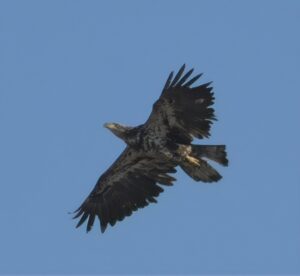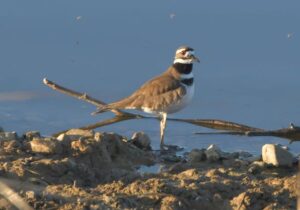Early morning has the reputation for being the best time to go birding. It’s definitely a sweet spot for peak bird activity, but as the days get longer, you might find it convenient to bird later in the day.
On April 2, we met at Stearns Lake at 5:30 pm. Even before leaving the parking lot, we had the opportunity to pick out a lone white Snow Goose among a hundred or so Cackling Geese. Snow Geese have a ‘grin patch’ – a dark patch on the side of the beak that makes the beak look open or like the bird is grinning. It’s not always easy to see the ‘grin patch’, but the setting sun provided ideal lighting conditions to do just that.
It wasn’t long before a Bald Eagle flew over the lake scattering the large flock of geese. Since 2012, a pair of Bald Eagles has nested near Stearns Lake. For several years, their nest was in a large cottonwood tree east of Del Corso Park, a small park wedged between apartment complexes that can be seen to the west of Stearns Lake. Last year, the Bald Eagles moved to a nesting tree south of Stearns Lake. This year, they’re nesting just southwest of the lake, much closer to the trail that leads you along the lake’s south and east shore.
The Bald Eagle that scared off the flock of geese wasn’t one of the adults in the nesting pair. By plumage, it appeared to be a second or third year individual. We watched as it headed straight for the eagle nest tree after flushing the geese. It was then promptly chased off by the adult male. We watched as the young individual approached the nest tree multiple times before being chased off again and again.
As we worked our way along the lake’s south shore, we practiced our waterfowl identification (ID) skills. We spotted a lone Gadwall, several Mallards, a Bufflehead pair, two pairs of Ruddy Ducks, and a Horned Grebe. The cerulean blue bill of male Ruddy Ducks in breeding plumage always rank high on the “wow-index”. We also discussed the distinct profile of Ruddy Ducks in the water – small body, scoop-shaped bill, and stiff tail often cocked upward.
The Horned Grebe offered another ID challenge. Both Horned and Eared Grebes had been reported in Boulder County recently. In poor light or from a distance, it can be challenging to tell the two species apart. Both are small and compact with black heads and showy head feathers. Neck color in breeding plumage differs between the two species, though. The Horned Grebe has a cinnamon neck and the Eared Grebe a black neck. Again, the setting sun
provided ideal lighting to see the cinnamon neck of this Horned Grebe through the spotting scope.
Other highlights of our walk included a pair of American Kestrels, our smallest and most common falcon “pair bonding”, a Great Blue Heron stalking prey in the lake’s shallows, and a Killdeer in beautiful Golden Hour lighting.
As the days continue to get longer in the coming weeks, consider taking an evening bird walk. It’s a wonderful way to end the day.
eBird Checklist – 20 Species
| Snow Goose |
| Cackling Goose |
| Canada Goose |
| Gadwall |
| Mallard |
| Bufflehead |
| Ruddy Duck |
| Horned Grebe |
| Rock Pigeon (Feral Pigeon) |
| Killdeer |
| Great Blue Heron |
| Bald Eagle |
| Red-tailed Hawk |
| American Kestrel |
| Black-billed Magpie |
| European Starling |
| American Robin |
| Western Meadowlark |
| Red-winged Blackbird |
| Great-tailed Grackle |
Front Range Birding Company’s blog readers get 10% of Best Birding Hikes – Colorado’s Front Range. Enter discount code FRBC at check out.




Comments
Write Comment